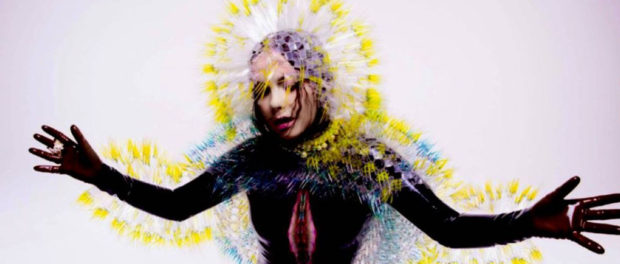Björk Digital: the cutting-edge of music, art and technology
The iconic Icelandic singer, songwriter and actress, Björk, is one of the most innovative artists of her generation. She has pushed the boundaries of artistic expression, blending technology, performance art and music, throughout her 40-year career. She bridges the divide between experimental musician and pop celebrity, with her use of unconventional instruments, warm passionate vocals, electronic beats and wild alien-like costumes.
Her self-titled debut album, Björk, was released in Iceland in December 1977, when she was just 12 years old. She’s since released nine albums, won five Brit Awards, been nominated for 12 Grammys, won best actress at Cannes for the Lars von Trier musical film, Dancer in the Dark, as well as an Oscar nomination for the soundtrack. The Museum of Modern Art (MoMA) in New York also recently put on a retrospective of her work, showcasing her contributions to contemporary music, video, film, fashion, and art.
Although seemingly ageless, Björk is now 50 years old. He latest work, Björk Digital, is an immersive virtual reality (VR) experience melding film, technology and art. The exhibit is an extension of her 2015 album, Vulnicura, which encapsulates Björk’s feelings after the demise of her 13-year relationship with artist Mathew Barney. The album and VR experience share the full emotional arc of Bjork’s journey from heartache and despair to empowerment and strength.

Björk Digital is exhibited at Montreal’s DHC/ART Foundation for Contemporary Art from October 15 to November 12, 2016, and presented by the Phi Centre and the Red Bull Music Academy . The exhibit is viewed in groups of 25 people and strictly limited to children over the age of 13 due to Oculus Rift’s safety guidelines.
Our group was escorted to a simple, dimly lit room, where VR goggles and headphones waited on bar stools. The stools allow the viewer to rotate their bodies to better view the 360-degree VR films. The exhibit consisted of 5 separate VR films described below, as well as a cinema showing a curated selection of Björk music videos, and some tablets set up with Björk’s Biophilia app.
The first four films were experienced with the Oculus Rift VR system and the grand finale with the even more immersive HTC Vive.
Black Lake
We slip on the VR goggles and we instantaneously find ourselves in a cave. Two screens showcasing complementary edits of the Black Lake video below is projected on the walls of the cave. Björk sings about heartache and torment to plaintive string arrangements. She dances and writhes as she finds her way out of the cave through blue lava and into a green mossy meadow to be rejuvenated.
The video is directed by Los Angeles-based filmmaker Andrew Thomas Huang and was commissioned by the Museum of Modern Art, New York.
Stonemilker
We are escorted into a separate room and slip on a new pair of Oculus Rifts to find ourselves on an overcast Icelandic beach with Björk in bright yellow, beautifully contrasting her surroundings. Shot on location in Iceland, it feels as though Bjork is putting on an up close and intimate performance just for me, and the 360-degree film is particularly spectacular. The only thing preventing me from being totally immersed is the slightly grainy quality of the Oculus Rift viewing technology.
Mouthmantra/Quicksand
Our group is brought to a third room where we view the next two VR films back-to-back. Mouthmantra takes place inside Bjork’s gigantic pulsating mouth. The mouth is in and out of focus; it moves and swirls. The overall experience is quite unpleasant and I have to close my eyes at some point due to dizziness and motion sickness.
The following film, Quicksand, shows Björk gradually metamorphosing into a digi-goddess with swirling multicoloured wires coming out of her head and body and going up to the sky.
Notget
Björk’s full metamorphosis into a powerful alien digi-goddess is complete for the big finale, Notget. This is experienced with the HTC Vive VR system, where we were able to stand up, move around interact with the Björk avatar using interactive “hands”. The experience so immersive and all consuming that one loses all sense of physical space.

Biophilia App
The last component of the exhibit was the Biophilia app, which is an extension of Björk’s previous album of the same name, released in 2011. Biophilia explores the themes of nature, music and technology, with songs composed with unusual instruments such as the tesla coil, gameleste and gravitational pendulum harps.
An app with games was created for each song on Biophilia, and can be used on tablets and mobile devices. The app’s activities range from playing Björk’s custom musical instruments to extracting DNA from an onion to watching cell division and DNA being produced.
The apps are musical education tools that explore the relationship between music and science. The Reykjavik City Board of Education decided to bring the app to all schools in the city for three years. The apps were also inducted into the New York Museum of Modern Art’s permanent collection.
In her new Björk Digital exhibition, Björk uses the most cutting-edge technology available to expand on her music and creative vision. Although VR technology is still in its infancy and there will be many improvements to come, one gets a glimpse of the potential VR has for art, music and entertainment. Bjork continues to be on the cutting-edge of music, art and technology with her boundless creativity and artistic courage.
Catch Bjork Digital from October 15 to November 12, 2016, at the DHC/ART Foundation for Contemporary Art (451 – 465 St-Jean Street, Montreal, QC, H2Y 2R6). Ticket Prices: $20 for adults (strictly ages 13+), $15 for students and seniors (Tuesdays: $5 discount on ticket prices). Click HERE.
Annie Webb writes the blog, The Spaced-Out Scientist.
1 Comment on Björk Digital: the cutting-edge of music, art and technology
Comments are closed.







Bien ecrit, annie!